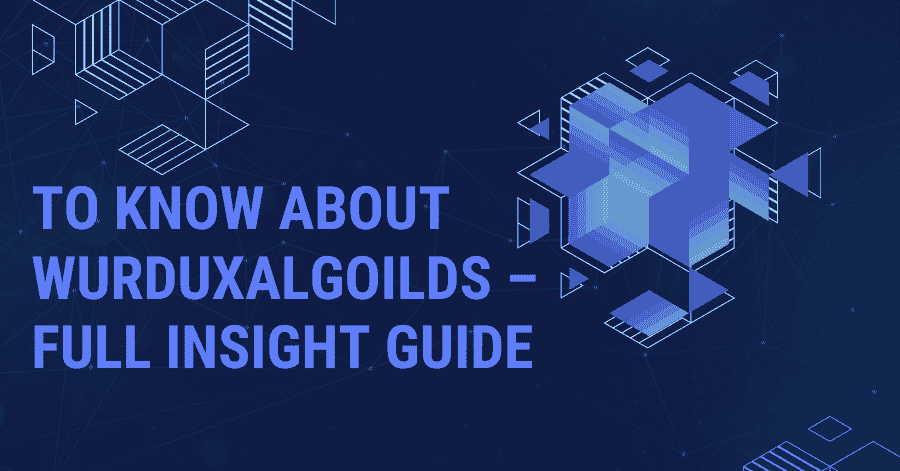In today’s fast-evolving digital landscape, the term “Wurduxalgoilds” has been gaining attention. Whether you’re new to the concept or have come across the term in online forums, research articles, or industry discussions, it’s time to fully understand what Wurduxalgoilds are and why they matter.
Also read this: Winqizmorzqux Product Details and User Feedback 2025
What Are Wurduxalgoilds?
These are a relatively new and enigmatic concept within the realm of digital systems, potentially relating to algorithmic operations, data flow structures, or blockchain-integrated processes. Though not widely recognized in mainstream technology literature, Wurduxalgoilds appear to be a niche or emerging category involving complex algorithms designed to optimize or control certain digital functions.
At their core, these constructs may integrate aspects of artificial intelligence (AI), automation, and machine learning to create adaptive responses within software ecosystems. This makes them particularly valuable in data science, cybersecurity, and decentralized systems.
Origin and Background of Wurduxalgoilds
The word “Wurduxalgoilds” seems to be a portmanteau or fusion term. Breaking it down:
- “Wurdux” could imply a proprietary or brand-based prefix.
- “Algo” typically denotes algorithms—step-by-step computational procedures.
- “Ilds” might refer to modules, builds, or systems.
It’s speculated that were first conceptualized by a tech group experimenting with AI-integrated blockchain frameworks. These systems aimed to create self-healing, auto-correcting algorithms that could adapt in real-time—unlike traditional static algorithms.
The development possibly originated in cryptographic labs or advanced academic environments focusing on next-gen coding systems.
How Wurduxalgoilds Work
While detailed technical documentation is sparse, available insights suggest that work through a layered model:
- Input Layer: Gathers data from various sources—IoT devices, user interaction logs, web scraping, etc.
- Processing Layer: Applies Wurdux algorithms to analyze patterns, identify errors, and forecast outcomes.
- Learning Module: A machine learning interface recalibrates the output over time.
- Output Interface: Offers predictions, reports, or directives for further action.
This structure helps Wurduxalgoilds adapt and “learn” over time, improving efficiency and minimizing risk or system failures.
Applications of Wurduxalgoilds
Depending on the field of implementation, have a wide range of potential uses:
1. Cybersecurity
These algorithms can identify security vulnerabilities in real-time, adapt to evolving threats, and propose solutions automatically.
2. Finance and Trading
It can optimize automated trading bots, detect anomalies in stock trends, and react faster than human analysts.
3. Healthcare Tech
In medical diagnostics, Wurduxalgoilds could help assess massive data sets from patient records, improving the speed and accuracy of diagnoses.
4. Smart Cities and IoT
These systems can manage traffic flow, public safety, and even utilities in urban environments through intelligent feedback loops.
5. Blockchain and Crypto
They can manage smart contracts, automate token swaps, or regulate decentralized autonomous organizations (DAOs).
Benefits of Using Wurduxalgoilds
Wurduxalgoilds offer multiple benefits, especially when compared to traditional algorithmic frameworks.
- Self-Adaptive: Their learning capabilities make them superior in evolving digital ecosystems.
- Error Reduction: Automated adjustments help reduce human errors.
- Efficiency: Faster data processing improves workflow and decision-making.
- Security: Enhanced detection of vulnerabilities makes systems more secure.
- Scalability: Can be scaled across networks with minimal reprogramming.
Risks and Limitations of Wurduxalgoilds
Despite their benefits, Wurduxalgoilds come with risks:
- Complexity: Difficult for general users to understand or control.
- Overfitting: Learning algorithms may become too narrow in scope.
- Dependence on Data: Poor data can result in flawed outputs.
- Ethical Concerns: Privacy and control can be compromised if algorithms go unchecked.
- Resource-Intensive: High computational needs might not suit all systems.
Comparison: Wurduxalgoilds vs. Traditional Algorithms
| Feature | Wurduxalgoilds | Traditional Algorithms |
| Adaptability | High | Low |
| Learning Capability | Integrated Machine Learning | Static, Non-Adaptive |
| Performance Speed | Faster with time | Consistent but limited |
| Maintenance | Low (self-correcting) | High (requires updates) |
| Use Cases | Advanced AI, Blockchain, Cybersecurity | General Programming Tasks |
The Future of Wurduxalgoilds
Looking ahead, Wurduxalgoilds may become the foundation for next-generation AI systems. With rising investments in AI, decentralized networks, and digital automation, the demand for more responsive, intelligent algorithms is inevitable.
Predictions include:
- Integration with quantum computing for ultra-fast processing.
- Use in autonomous robotics and vehicles.
- Application in environmental modeling and crisis simulations.
As adoption grows, so will the need for regulation, documentation, and accessibility in this field.
Also read this: How to Use MEGA Cloud Storage: A Complete 2025 Guide
FAQs About Wurduxalgoilds
Q1: Are Wurduxalgoilds available as open-source tools?
At this time, most Wurduxalgoild frameworks appear to be proprietary or research-based, with few available as open-source tools.
Q2: Can Wurduxalgoilds replace traditional coding methods?
Not entirely. While they can enhance many processes, basic coding will always be necessary for foundational tasks.
Q3: Are they safe to use in enterprise environments?
With proper vetting and monitoring, yes. However, their complexity means only experienced developers should handle deployment.
Q4: Do Wurduxalgoilds require special hardware?
Some may require advanced processing power, especially those that handle large datasets or rely on real-time analysis.
Q5: Who should learn about Wurduxalgoilds?
Developers, cybersecurity professionals, data scientists, and tech entrepreneurs can all benefit from understanding Wurduxalgoild systems.
Conclusion
Wurduxalgoilds may seem like a futuristic or niche concept, but they reflect a broader trend toward intelligent automation, self-learning systems, and algorithmic efficiency. As technology evolves, so will the algorithms that drive it—and Wurduxalgoilds may very well lead the way.
Understanding their function, potential, and limitations now can help businesses, developers, and everyday users prepare for what’s coming next in digital innovation.
Whether you’re planning to adopt them into your systems or just want to stay informed, this guide provides the knowledge you need to know about Wurduxalgoilds—and how they’re shaping the digital future.










